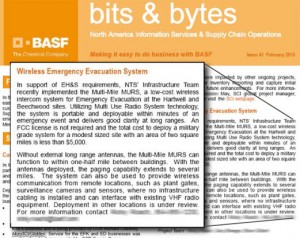Quickly Implement A Wireless System For A Fraction Of The Cost Of A Wired System.
Meeting the compliance requirements of Environmental Health & Safety (EH&S) standards can be a very costly endeavor, but one company found a way to save tens of thousands of dollars on part of these standards.
The world’s leading chemical company, saved money implementing OSHA’s Employee Alarm System standard 29 CFR 1910.165. According to the standard, “An employee alarm system can be any piece of equipment and/or device designed to inform employees that an emergency exists or to signal the presence of a hazard requiring urgent attention.”
This company looked at a wired system and got a quote for about $70,000 to install the system. Installing this wired system would have required running thousands of feet of wire and the labor cost alone was over $40,000.
They instead turned their focus to a wireless solution. What they discovered is that not only is the cost of a wireless system far less, but they could install the system in as little as a day or two.
The cost of the wireless equipment they needed was less than $12,000 versus the $70K for a wired system. They installed the system themselves so installation cost was also greatly reduced. The result was over $50K in savings.
The heart of their system is the MURS Wireless PA (public address) system that is placed around various locations of their building and property. This is what enables personnel to broadcast an emergency message without having to run wires everywhere.
The PA system consists of a receiver unit with antenna that receives transmissions, amplifies them, and then sends them to attached PA horn speakers. Each receiver location can be set to different volume levels depending on the environment around them.
To activate this emergency notification system, there are a couple of options available. For one, the transmitter sending the message can be in the form of a portable 2-way radio, mobile vehicle radio, or base station intercom that can be used to make live voice announcements from anywhere. These announcements can be used to make guided evacuations or to tell employees to take cover if bad weather is approaching.
The second option is to use a device called the MURS Voice Notification Wireless Monitor that broadcasts a previously recorded message when someone presses a button. Two messages can be recorded with two separate buttons to activate them.
Another benefit of a wireless PA system over a wired system is that handheld two-way radios can be used to make announcements. So no matter where emergency personnel are, they can make announcements. Even if they are up to two miles away or more with the use of external antennas. If a wired PA system is already in place, a Wireless PA System Interface device is available that will receive transmissions from radios and then broadcast those transmissions over a wired PA system.
These wireless PA units are available in both UHF and VHF frequencies so they can be used with existing two-way radios. The MURS model has five frequencies that do not require an FCC license.
One more benefit of a wireless system is that the VHF MURS Wireless PA version of these units can also be programmed to receive automatic transmissions from NOAA Weather Radio so employees instantly know when bad weather is approaching.
So when this company needed to implement an employee emergency evacuation system, they went to www.IntercomsOnline.com to purchase a wireless system that could be quickly installed without all the hassles and expense of installing a wired system.
